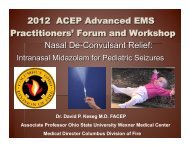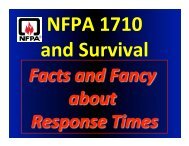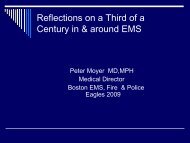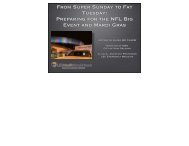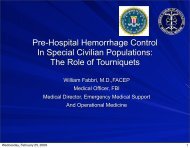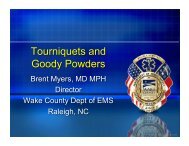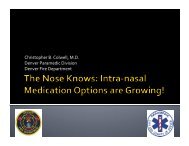EMS Point of Care Saliva Testing for Cardiac Injury Markers
EMS Point of Care Saliva Testing for Cardiac Injury Markers
EMS Point of Care Saliva Testing for Cardiac Injury Markers
Create successful ePaper yourself
Turn your PDF publications into a flip-book with our unique Google optimized e-Paper software.
<strong>Saliva</strong>ry Diagnostics<br />
Craig Manifold, DO<br />
Medical Director, San Antonio Fire Department<br />
Original Presentations by:<br />
Spencer Redding, DDS<br />
David Wampler, PhD
<strong>Saliva</strong>ry Diagnostics<br />
• Preliminary<br />
In<strong>for</strong>mation<br />
– Not yet ready <strong>for</strong><br />
Prime Time<br />
• Three Major<br />
Concepts<br />
– <strong>Saliva</strong>ry Diagnostics<br />
– <strong>Point</strong> <strong>of</strong> <strong>Care</strong> <strong>Testing</strong><br />
– Lab on a Chip
<strong>Saliva</strong>ry Diagnostics<br />
• Is it comparable to<br />
blood<br />
• Biological fluid that<br />
contains many<br />
analytes<br />
• Non-invasive<br />
collection<br />
– Easily done at<br />
multiple outpatient<br />
settings
<strong>Saliva</strong>ry Diagnostics<br />
• Utilized in other<br />
disease processes<br />
– Cancer<br />
– Infectious disease<br />
– Diabetes mellitus<br />
– Potential <strong>for</strong> virtually<br />
any disease
<strong>Point</strong> <strong>of</strong> <strong>Care</strong> <strong>Testing</strong><br />
• Gurney/bedside vs. Centralized lab<br />
• Cost <strong>of</strong> equipment greatly reduced<br />
• Results in 10-15 minutes vs 1-6 hours
<strong>Point</strong> <strong>of</strong> <strong>Care</strong> <strong>Testing</strong><br />
QuickTime and a<br />
DV/DVCPRO - NTSC decompressor<br />
are needed to see this picture.<br />
• Samples placed on individual card <strong>for</strong> the<br />
appropriate test<br />
• Card placed in common analyzer where<br />
result is reported
Lab on a Chip
Lab on a Chip<br />
QuickTime and a<br />
DV/DVCPRO - NTSC decompressor<br />
are needed to see this picture.<br />
• Sample placed on card<br />
• Card placed in analyzer
<strong>Cardiac</strong> Diagnostics<br />
At Risk <strong>Testing</strong><br />
(CRP, TNF<br />
Alpha, IL1-data,<br />
WBC)<br />
Congestive Heart<br />
Failure Prognosis<br />
(BNP, Pro BNP,<br />
Urotensin)<br />
Acute Coronary Syndrome<br />
(IMA,D-dimer, Troponin I,<br />
Troponin T, CKMB, Myoglobin<br />
and Digoxin)
Time Course <strong>of</strong> Established AMI Biomarkers in<br />
Serum
Biomarkers <strong>of</strong> ACS<br />
*<br />
*<br />
*<br />
Biomarkers<br />
<strong>of</strong> ACS in<br />
serum<br />
Biomarkers<br />
<strong>of</strong> ACS in<br />
saliva<br />
Ratio <strong>of</strong> median concentration <strong>for</strong> the ACS (NSTEMI<br />
&STEMI) over median concentration <strong>for</strong> the controls
Sensitivity (true positives)<br />
Sensitivity (true positives)<br />
ROC Curves <strong>for</strong> 21 and Top-5 Biomarkers<br />
<strong>for</strong> AMI Diagnosis<br />
SERUM (UK & UL)<br />
SALIVA (UK & UL)<br />
1<br />
1<br />
0.9<br />
0.9<br />
0.8<br />
0.8<br />
0.7<br />
0.7<br />
0.6<br />
0.6<br />
0.5<br />
0.5<br />
0.4<br />
0.4<br />
0.3<br />
0.2<br />
0.1<br />
0<br />
No discrimination<br />
all serum<br />
Top 5 serum<br />
0 0.5 1<br />
1 - Specificity (false positives)<br />
0.3<br />
0.2<br />
0.1<br />
0<br />
No discrimination<br />
all saliva<br />
Top 5 saliva<br />
0 0.5 1<br />
1 - Specificity (false positives)<br />
43 Controls, 23 NSTEMI, 25 STEMI
Sensitivity (true positives)<br />
Sensitivity (true positives)<br />
ROC Curves <strong>for</strong> Combination EKG and <strong>Saliva</strong><br />
Biomarker Panel<br />
SERUM (UK & UL)<br />
SALIVA (UK & UL)<br />
1<br />
0.9<br />
0.8<br />
0.7<br />
0.6<br />
1<br />
0.9<br />
0.8<br />
0.7<br />
0.6<br />
0.5<br />
0.4<br />
0.3<br />
0.2<br />
0.1<br />
0<br />
No discrimination<br />
Triage BMs<br />
Triage & EKG<br />
EKG<br />
0 0.5 1<br />
1 - Specificity (false positives)<br />
0.5<br />
0.4<br />
0.3<br />
0.2<br />
0.1<br />
0<br />
No discrimination<br />
CRP & MPO<br />
EKG<br />
CRP MPO & EKG<br />
0 0.5 1<br />
1 - Specificity (false positives)<br />
43 Controls, 23 NSTEMI, 25 STEMI
Dose Response<br />
Curves<br />
IL1b<br />
CRP<br />
MPO<br />
MYO<br />
CRP<br />
0.2 ng/mL<br />
IL1b<br />
0.2 ng/mL<br />
MPO<br />
5 ng/mL<br />
MYO<br />
0.2 ng/mL<br />
CRP<br />
2 ng/mL<br />
IL1b<br />
2 ng/mL<br />
MPO<br />
50 ng/mL<br />
MYO<br />
2 ng/mL<br />
CRP<br />
20 ng/mL<br />
IL1b<br />
20 ng/mL<br />
MPO<br />
500 ng/mL<br />
MYO<br />
20 ng/mL<br />
NEGATIVE<br />
CAL<br />
NEGATIVE<br />
g15, <strong>of</strong>f0, 0.25”exp 10/14/0<br />
CAL<br />
NEGATIVE<br />
CAL
CRP<br />
CAOI (0.25”)<br />
MPO<br />
CAOI (0.25”)<br />
UT002<br />
g15/<strong>of</strong>f0/0.75”<br />
IL1b Standard<br />
Curve<br />
Healthy Donor – UT002<br />
CRP IL1b MPO MYO<br />
Ambulance Patient - <strong>EMS</strong>2<br />
CRP IL1b MPO MYO<br />
Ambulance Patient- <strong>EMS</strong>3<br />
CRP IL1b MPO MYO<br />
NEGATIVE<br />
CAL<br />
NEGATIVE<br />
CAL<br />
NEGATIVE<br />
CAL
<strong>EMS</strong> Study<br />
• Is there a role <strong>for</strong> salivary markers in<br />
the pre-hospital setting<br />
• Can they replace blood tests <strong>for</strong><br />
definitive diagnosis by reducing time<br />
from diagnosis to treatment
<strong>EMS</strong> Study<br />
• Collect saliva<br />
samples from<br />
patients with ACS<br />
symptoms<br />
• Evaluate <strong>for</strong><br />
markers found in<br />
University <strong>of</strong> Kentucky MI<br />
study<br />
• Correlate with<br />
diagnosis <strong>of</strong><br />
STEMI/NSTEMI
<strong>EMS</strong> Study<br />
• Faculty from UTHSCSA<br />
School <strong>of</strong> Health Pr<strong>of</strong>essions<br />
Coordinate:<br />
– patient recruitment<br />
– patient history<br />
– collection <strong>of</strong> samples<br />
– Ge<strong>of</strong>f Smith, LP<br />
– David Wampler, PhD, LP
SAFD Paramedics<br />
• Danny Zamora<br />
• Timothy Worley<br />
• Christopher Velasquez<br />
• Trenton Thames<br />
• Greg Tetsch<br />
• Hank Schott<br />
• Robert Payne<br />
• Mark Olson<br />
• James Murray<br />
• Michael Mumme<br />
• Juan Morin<br />
• Donald Merecka<br />
• Jeremy McElroy<br />
• Ray Mays<br />
• Terrence D Lowe<br />
• Mark Lerma<br />
• Jonathan Hosek<br />
• Alberto Garcia<br />
• Joel Fox<br />
• Marti Flores<br />
• Robert Dugie<br />
• Kenneth Dugger<br />
• Michael Dixon<br />
• Eli Dierkhising<br />
• Kevin Cryus<br />
• Kristy Crenshaw<br />
• Kelvin Broadnax<br />
• Peter Baron
Requirements <strong>for</strong> Study<br />
Enrollment<br />
• IRB Training 1 Hour<br />
• Study Training 1 Hour<br />
• Review/Updates 1 hour,<br />
Group mtg<br />
• Research Assistant– Bi-<br />
Weekly phone reminder<br />
• Cooler issued<br />
• Swab obtained<br />
• Sampled delivered to<br />
VA<br />
• Verbal consent by<br />
paramedic followed by<br />
<strong>for</strong>mal consent postevent
• Cardiologist will<br />
confirm patient<br />
diagnosis<br />
• <strong>Saliva</strong>ry diagnostics<br />
lab will process<br />
samples <strong>for</strong> delivery<br />
to Rice University<br />
<strong>EMS</strong> Study
• <strong>Markers</strong> will be<br />
analyzed using lab<br />
on a chip technology<br />
<strong>EMS</strong> Study
<strong>EMS</strong> Study<br />
• Potential Findings:<br />
– Increase accuracy <strong>of</strong><br />
diagnosis in<br />
combination with<br />
ECG<br />
– Reduce diagnosis<br />
time<br />
– Alter treatment
<strong>Saliva</strong> ACS biomarker testing in ambulance<br />
User: paramedics, highly<br />
trained<br />
Environment: <strong>EMS</strong> vehicle,<br />
battery power, significant<br />
vibrations, compact<br />
Accessories: used in<br />
connection with EKG, radio<br />
communications with<br />
hospital<br />
12 lead EKG used by paramedics<br />
to transmit initial findings to<br />
emergency room physicians.<br />
EKG does not diagnose NSTEMI<br />
cases.<br />
<strong>Saliva</strong> testing allows <strong>for</strong><br />
identification <strong>of</strong><br />
NSTEMI patients
Results<br />
• Acute Coronary<br />
Syndrome/ Chest<br />
Pain<br />
• Recruited 29/ 120<br />
patients<br />
• 7 Confirmed<br />
STEMI/NSTEMI<br />
• 3 Heart Failure
• Is this important<br />
• Will it alter<br />
therapy<br />
• Does it improve<br />
outcomes
Acknowledgements:<br />
• San Antonio Fire Department<br />
• Dr. Spencer Redding<br />
• David Wampler, PhD<br />
• Ge<strong>of</strong>f Smith<br />
• Chih-Ko Yeh<br />
• Alan Lin<br />
• Terry Baucher<br />
• John McDevitt<br />
• Funded Grant NIH “Development <strong>of</strong> a lab on<br />
a chip system <strong>for</strong> saliva based diagnostics””
<strong>Saliva</strong>ry Diagnostics<br />
Projects<br />
• Four funded Groups<br />
– UT Austin-UTHSCSA-UK-UL<br />
• <strong>Cardiac</strong> disease<br />
– NYU<br />
• Tuberculosis<br />
– UCLA<br />
• Oral cancer<br />
– Tufts
Future



